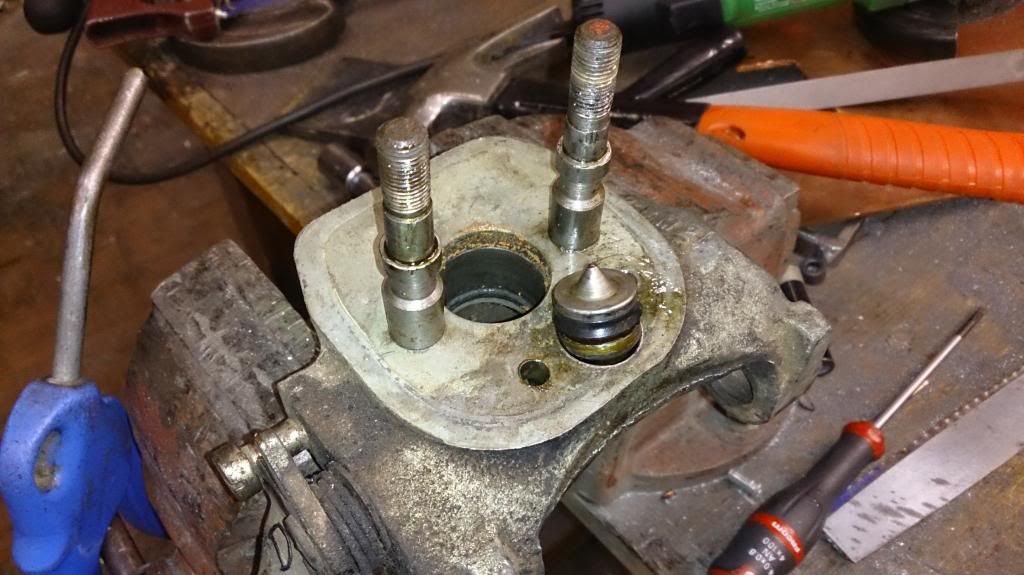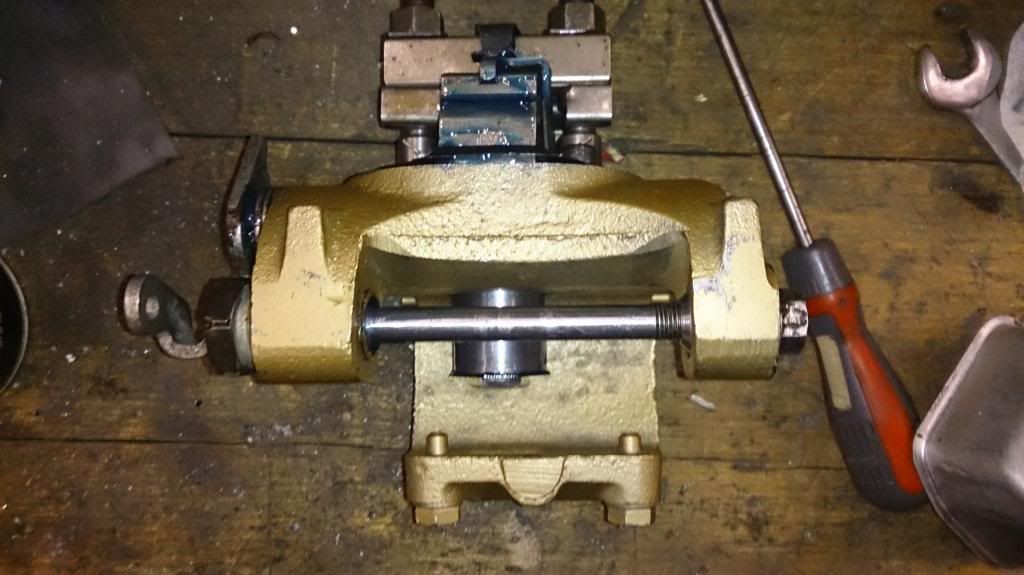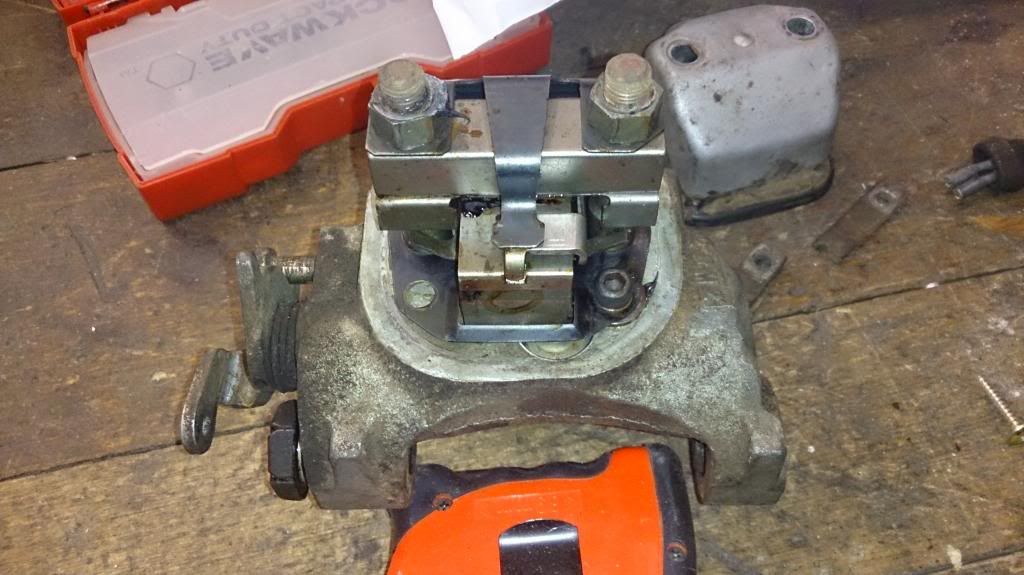You are using an out of date browser. It may not display this or other websites correctly.
You should upgrade or use an alternative browser.
You should upgrade or use an alternative browser.
rear caliper overhaul
- Thread starter quattro
- Start date
John said:Harvey, why would they need to be sleeved if built up correctly with Girling grease?
I have a friend who has a Dagenham Flying Pig, and his description of Girling calipers makes mine suitable for a vicars tea party. (But he is a pure bred Yorkshireman!)
John.
The piston bores corrode and pit, regardless of any grease used, so the only permanent solution is to sleeve the bores with stainless.
The Fords used to suffer a lot with the pivot pins seizing as they were outboard, but although they were as troublesome as the Rover ones I only ever did one of them.
DaveHerns said:Don't early Rolls Royce Silver Shadows have rear calipers and separate hand brake shoes ? Is that the Dunlop system ?
They do have seperate handbrake pads, tiny little things that barely hold the car, and won't slow the car if its moving. They use 4 Ford Girling calipers on the front, so I assume they have one of the same, or similar, on the rear. I have worked Shadow 1's, but can't remember offhand, apart from remembering what a cr*p car they are to drive and to work on, and you pay handsomely for the privilege.
robgee1964
Member
chrisyork said:Parts availability is now superior to the Girling's, thank to commonality with early Jag rear brakes. But perhaps I'm biased - I've got a set of Dunlops in the garage
Chris
Thats not really correct, although the handbrake caliper is the same as on the inboard brake jags, the footbrake caliper is a totally different thing to those Dunlop ones used on the early Rovers.
FWIW an old work colleague had a P6 brand new, back in the mid 1960's. I do recall him saying on more than one occasion that the Dunlop system had the reputation of being rather troublesome, and that the later Girling brakes gave a lot less bother.
Personally I don't think those Girling calipers are too bad, and at least they can be disassembled and rebuilt quite easily, unlike a lot of modern rear calipers. Although they are not ideally placed, they are significantly easier to get off than the jag calipers; provided you remove the two as a pair they can be slid over the disks, diff/disks/driveshafts can all stay in place.
robgee1964
Member
Perhaps your thinking of the series I E types, they have different calipers. However series II E types and all the other inboard disk jags have an arrangement which looks much more like the Girling fronts on the P6, with very similar looking pads. At the top, the casting has some lugs on it, onto which the handbrake caliper assembly is affixed, via the two pivot bolts. The only thing they have in common with the P6 calipers is both types have an external bridge pipe.
From the pictures, this handbrake caliper does look identical to the ones used on all the inboard disk jags. It sounds like the Dunlop ones got ditched on all makes sometime in the mid 1960's. Which makes it quite suprising that spares could be more plentiful than for the later setup, which ran for far longer. Its true that the rear calipers are one on their own, shared only with Ford Zephyr/Zodiac as far as I'm aware, but the fronts are used on a variety of cars from that era.
I wonder if the girling style jag rears could be fitted to a P6? They are mega easy to get bits for as there are so many about
From the pictures, this handbrake caliper does look identical to the ones used on all the inboard disk jags. It sounds like the Dunlop ones got ditched on all makes sometime in the mid 1960's. Which makes it quite suprising that spares could be more plentiful than for the later setup, which ran for far longer. Its true that the rear calipers are one on their own, shared only with Ford Zephyr/Zodiac as far as I'm aware, but the fronts are used on a variety of cars from that era.
I wonder if the girling style jag rears could be fitted to a P6? They are mega easy to get bits for as there are so many about
ewokracing
Active Member
Hi Geoff,
It is supposed to be moisture absorbing paper, but personally I think they serve little purpose. I have a set of NOS rear calipers that were completely wrapped in genuine sticky moisture absorbing paper, but that combined with the paper within didn't stop the steel bores from corroding. So before I can use them, they will have their cylinders resleeved in stainless steel.
If you smear some grease around, that in my view would be more beneficial that pieces of paper.
Ron.
It is supposed to be moisture absorbing paper, but personally I think they serve little purpose. I have a set of NOS rear calipers that were completely wrapped in genuine sticky moisture absorbing paper, but that combined with the paper within didn't stop the steel bores from corroding. So before I can use them, they will have their cylinders resleeved in stainless steel.
If you smear some grease around, that in my view would be more beneficial that pieces of paper.
Ron.
Vern Klukas
Active Member
SydneyRoverP6B said:Hi Geoff,
It is supposed to be moisture absorbing paper, but personally I think they serve little purpose. I have a set of NOS rear calipers that were completely wrapped in genuine sticky moisture absorbing paper, but that combined with the paper within didn't stop the steel bores from corroding. So before I can use them, they will have their cylinders resleeved in stainless steel.
If you smear some grease around, that in my view would be more beneficial that pieces of paper.
Ron.
The paper emits a fume that prevents the corrosion. Nothing wrong with it at all, it works perfectly. But only for a few years, not twenty! The outer, sticky paper is just waterproof, you were meant to wrap what it was up in and make sure that all the edges sealed against one another.
Yours
Vern
ewokracing
Active Member
I have the same late calipers as quattro - mine had the small piece of metal which bridged across the innards of the caliper.
When we talk about sleeving, I assume we are talking about a sleeve being fitted to the hole where the part 601916 - the mechanical piston/cup slides?
Just that mine looks ok on the one caliper I have disassembled:

I have totally stripped the caliper and there is a buildup of sludge in some of the orifices. Should I leave the body of the caliper to sit in some brake cleaner to get everything nice and loose so I can brush it out?
(ie the threads are full of gunk which might be why it was leaking from the bleed nipple).
When we talk about sleeving, I assume we are talking about a sleeve being fitted to the hole where the part 601916 - the mechanical piston/cup slides?
Just that mine looks ok on the one caliper I have disassembled:

I have totally stripped the caliper and there is a buildup of sludge in some of the orifices. Should I leave the body of the caliper to sit in some brake cleaner to get everything nice and loose so I can brush it out?
(ie the threads are full of gunk which might be why it was leaking from the bleed nipple).
Hi Geoff,
Yes the cylinder as seen in your photo above is the one that is resleeved in stainless steel. Definitely worth doing, actually I am amazed that they have not already been done. Will provide reliable trouble free operations for a good ten years or more between overhauls.
Soaking in brake cleaner sounds a good idea, but be very careful as that stuff is seriously toxic, especially when the liquid is exposed to any form of heat resulting in boiling. Inhaling the ensuing fumes can result in permanent kidney and liver damage. :shock:
Ron.
Yes the cylinder as seen in your photo above is the one that is resleeved in stainless steel. Definitely worth doing, actually I am amazed that they have not already been done. Will provide reliable trouble free operations for a good ten years or more between overhauls.
Soaking in brake cleaner sounds a good idea, but be very careful as that stuff is seriously toxic, especially when the liquid is exposed to any form of heat resulting in boiling. Inhaling the ensuing fumes can result in permanent kidney and liver damage. :shock:
Ron.
ewokracing said:I have the same late calipers as quattro - mine had the small piece of metal which bridged across the innards of the caliper.
When we talk about sleeving, I assume we are talking about a sleeve being fitted to the hole where the part 601916 - the mechanical piston/cup slides?
In a word, NO
The sleeve would be fitted where the hydraulic piston is, i.e. 601918, under where it is sitting now.
Some brake cleaners are based on Dichloromethane (methylene chloride) and can be harmful to aluminium if soaked in it. Make sure there are no alloy parts around as it can form Hydrochloric Acid if it is allowed to react.
Richard
I sell glue to people, and have found in the past that certain glues, which contain dichlormethane make the insides of the aluminium pots and tubes go black. It also formed a black substance which blocked the guns. We found that the reaction with dichoremethane and aluminium formed Hydrochloric Acid which in turn attacked the aluminium and formed a black ash. This ash mixed with the glue to form the black sludge and blocked the gun tips. Nasty stuff :shock:
ewokracing
Active Member
Ron & Richard
thanks guys.
interestingly, there was a lot of browny black sludge on certain parts inside the caliper. I'll throw more pictures up after the xmas season.
thanks guys.
interestingly, there was a lot of browny black sludge on certain parts inside the caliper. I'll throw more pictures up after the xmas season.
ewokracing
Active Member
ewokracing
Active Member
So I have one caliper back together (I think!). Question though about the piston.
I turned the thingy bit on top three times (as others have noted), then had to push the piston down to get it all back together. So it all looked like this.

Then I was a bit stuck on how to get the piston back in so that I could fit the pads. I screwed it clockwise a few times, so now it looks like this.

Do I keep screwing it clockwise until I can fit the pads in or have I stuffed it completely? I read the workshop manual but it's hot and I couldn't make heads nor tails of it...
I turned the thingy bit on top three times (as others have noted), then had to push the piston down to get it all back together. So it all looked like this.

Then I was a bit stuck on how to get the piston back in so that I could fit the pads. I screwed it clockwise a few times, so now it looks like this.

Do I keep screwing it clockwise until I can fit the pads in or have I stuffed it completely? I read the workshop manual but it's hot and I couldn't make heads nor tails of it...
As Dave advised Geoff, keep winding the piston in until you hear it start to click. It will be almost fully home when this happens. Make sure that you position the tag upright, (closest to the casting) like you have in the first photo. You'll need to take out the drag pins again in order to locate the outer pad when you're refitting them.
Ron.
Ron.



